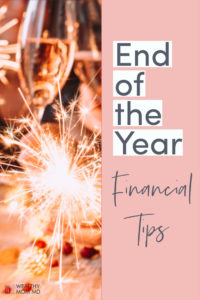Money
This is a guest post by Dr. Linda Street. Dr. Linda Street is a Certified Life Coach with a focus on Negotiations, a Board-certified Obstetrician and Maternal Fetal Medicine specialist, blogger, speaker and Founder/admin of NegotiatHER facebook group.
Up until now, your entire medical education has been an uphill climb competing for a few choice spots. Shifting gears from vying for that coveted position at your ideal program to interviewing for your first job is a complete 180-degree turn. This is one of the most important financial choices you will make. How much you earn directly correlates to how much you can save/invest/spend etc. AND is the jumping point for all future salary increases.
So now that I’ve convinced you this is important, how do you do it?
The most crucial step to nailing a negotiation is preparation. Preparation begins with finding the right job (or two if you want more leverage). Next comes offers. What about your offer do you like? What don’t you like? Look at it from the lens of your needs, then go back and look at it to gain insight on your potential employer’s needs to help frame your negotiation. Next, follow these 6 steps.
Ace the negotiation before you walk into the door (or bomb it…)
90% of negotiation is mindset. Managing your mind is essential. Stick with me. Let’s look at a tale of two docs.
- Doctor A is terrified of negotiating. She is convinced she’s bad at it. She thinks they won’t give her any more than the initial offer so why bother. Doc A isn’t sure she deserves any more money and is glad they’re offering her a job and not seeing her as the imposter she thinks she is. She is likely to take their first offer and call it a day.
- Doctor B hasn’t negotiated before either, but she knows she can figure things out. She knows the value she brings and shows up with confidence. Doc B feels like this is important enough to do her homework and get the best deal possible.
These two docs have the same skill set. Who do you think gets the better deal? Who do you want to hire?
Doctor B comes out ahead for two reasons,
- She asks for what she’s worth and she expects she’ll get it.
- She exudes confidence and that makes her employer WANT her more which makes them more likely to respect her requests. Wouldn’t you want a confident partner who can stay collected under pressure?
If you need help with this spend some time writing out everything you have to offer and why they would be lucky to have you. If you need more help, consider hiring a coach. This is not the place to pinch pennies and the return on your investment will be worth it. Your mindset sets the stage for the entire process.
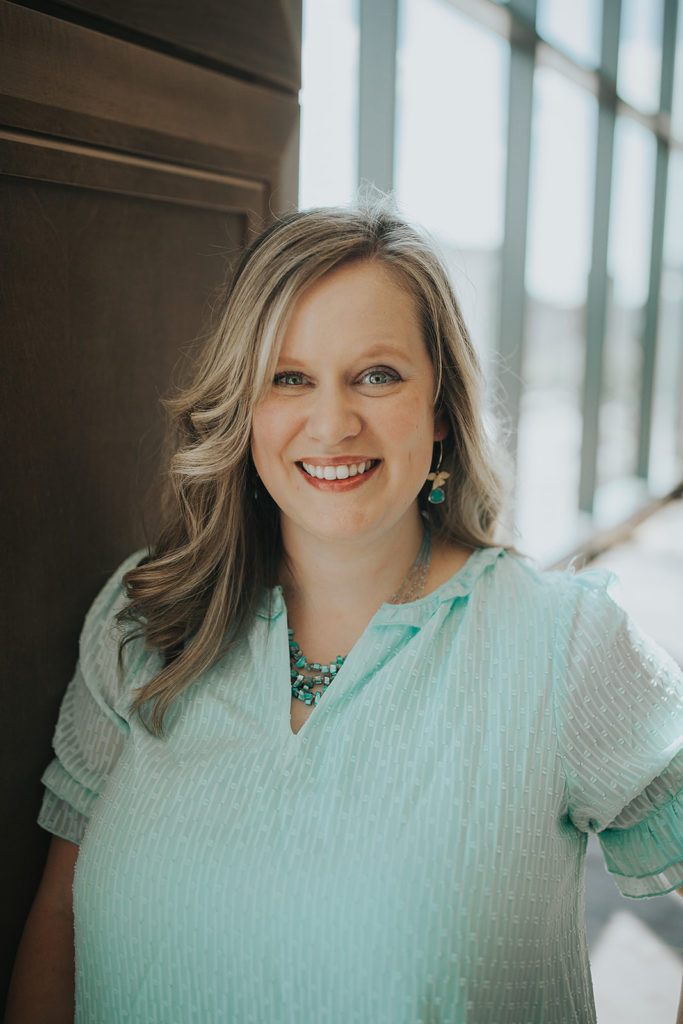
Don’t accept a Corolla on a Tesla Budget
Know your worth. If you walk in with no idea of what you SHOULD be being paid you will have absolutely no idea whether your offer is good or bad. You don’t want to be offered a 5th percentile salary and say yes just because it dwarfs your PGY-4 paycheck. It also may not serve you to walk in fresh out of training asking for a salary in the 99th percentile. So due diligence is key.
Great resources include:
- Co-residents who recently graduated (the stigma against discussing money has got to stop!) and faculty in your training program.
- Survey-based data such as
Having an idea of what you would like to make BEFORE you have a job offer is a great way to look at this objectively before your brain is constrained by an offer in hand. Write this down, aim for no lower than the 50th percentile for your field (better yet aim for the 75th!). Richard Shell, a professor at Wharton Business School and author of “Bargaining for Advantage: Negotiation Strategies for Reasonable People” teaches that JUST by having higher expectations people on average negotiate a higher amount.
The only failure is not asking
We’re brought up to think failure is kryptonite for eery type A medical brain. But what if it wasn’t? What if failure was just learning one way that didn’t work and then going back and asking a different way? The only failure in negotiation is not asking. Do NOT be afraid to ask! Odds are your future group EXPECTS you to negotiate. Their first offer is simply a jumping-off point, view it as such. Look at the contract and evaluate it critically, have a trusted mentor/friend/lawyer help (do NOT skip the lawyer!).
Where is the salary compared to the goal you set in the last step? What is the bonus structure? How does your compensation change over time (i.e. when do you become partner? What is your buy-in? When can you expect a raise? Does the compensation change from guarantee to production?) This segues nicely into the next step.
Understand how you are paid
A little homework in compensation structures will go a long way. Payment for physicians can come from many different buckets, common ones include
- Salary (aka “guarantee”)- this is money that shows up in equal increments in your paychecks. This doesn’t vary based on what you do. The advantage of a pure salary position is that it is reliable, the caveat is that you get paid the same no matter how hard you work.
- Production based- this comes in two flavors, collections (impacted by collection rates, payer mix, lag time) or work relative value units or wRVU. wRVU is a standardized measure assigned by CMS that is based on the encounter or procedure you are billing. Your employer will then assign a certain dollar value to each wRVU which can either be tiered or not and then you’re paid based on how many wRVUs you earn. There’s a great calculator at https://www.aapc.com/practice-management/rvu-calculator.aspx that lets you calculate how many wRVU’s you get per common CPT codes. If I am speaking Greek here you may need to do some googling, these terms will likely be important in attending life!
- A Hybrid model- Any imaginable mix of the above with a base salary and a bonus structure based on wRVUs or collections (or quality metrics etc.)
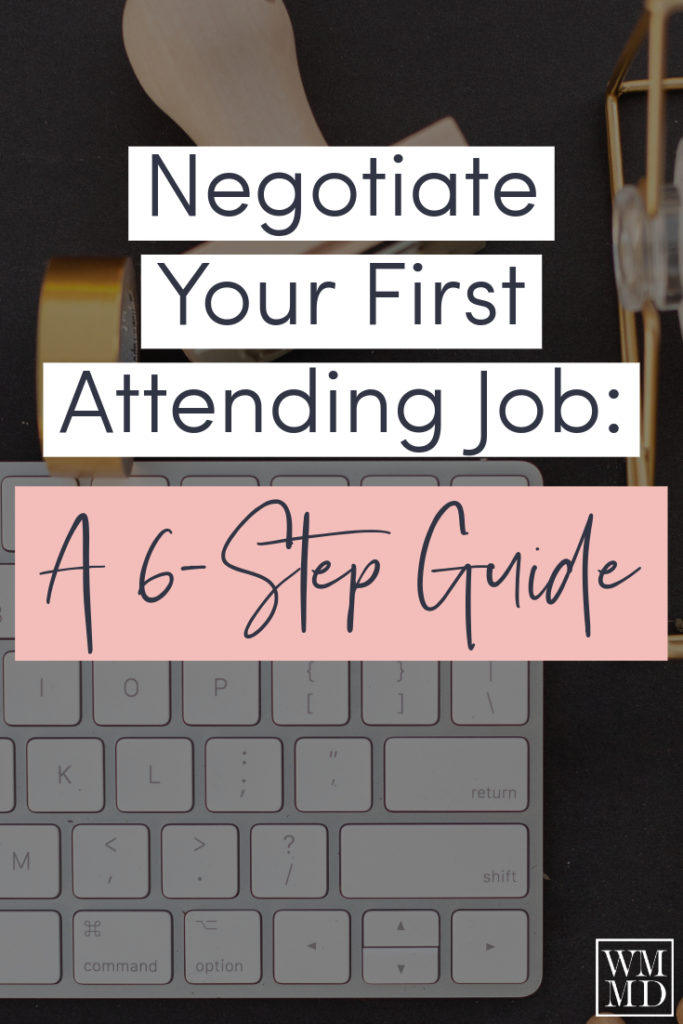
But wait, Money isn’t everything
Know the value of non-financial asks. These are things that can have enormous value to you personally but do not always have a dollar amount associated with them. Non-financial asks are a great way to sweeten the pot when you are close to making a deal but not quite there. These are things like benefits (health insurance, vision, dental, contribution to retirement accounts) vacation time/PTO, administrative time (for charting catch up, participation in hospital committees, teaching) and things that make your life easier (scribes, etc.)
You’re marrying your job, don’t do it without a prenup
While many of us want our job to be the perfect fit and last forever, that is typically not the case. While this varies by specialty, a quick google search reveals that up to 70% of doctors leave their first job within 5 years. This makes it absolutely essential to plan for this in your contract. Two main considerations are
- Malpractice tail insurance. If you are offered an occurrence-based malpractice policy, congratulations you can stop reading. However, most policies are claims-made which means that if you leave your employer and get sued afterwards you’ll need some coverage. This is where tail insurance is important, it covers you until a suit can no longer be filed. Depending on what area of the country you practice in and what specialty you are this could vary from being a nuisance purchase to a 6 figure investment. If you are able to negotiate it into your contract it’s simply taken care of. Some places will foot the entire bill and others will be willing to incorporate tail insurance as an incremental benefit based on how long you stay in your job (i.e. if you stay 1 year they’ll pay 25% of your tail and increase for each year you stay with complete payment if you stay more than say 3-5 years).
- Restrictive covenants or “non-competes”. Enforceability depends on what state you practice in, but the process can be a headache at best and a legal battle at worst. While you’re on the front end it's wise to assume that this will be enforceable and negotiate to either not have one or to limit the distance/time frame.
This is an exciting time to transition from training into actually doing what you have always wanted to do. Make sure you can do it with peace of mind by following these 6 simple steps to ensure you’ve negotiated the job of your dreams.
Giving to charity and to those in need is on most people’s mind this time of year. The new higher standard deductions that came with the recent tax changes have made it more challenging to deduct donations.
I hope no one gives just for the tax break, but paying less taxes is always a good thing. So, what can you do? Consider opening a Donor Advised Fund!
What is a Donor Advised Fund (DAF)?
A donor advised fund is an investment account for charity. You donate cash or investments. You can then donate to charity from the fund and invest it so it can keep growing (and can keep giving).
The year you donate to the DAF counts as a charitable contribution. Then you are free to take your time to give to individual charities. This means you can make larger lump sum donations strategically, say every other year or so, so that you are able to itemize deductions on your taxes.
But the best part, in my opinion, is that you don’t need to keep track of every donation you make for taxes anymore. You got the tax deduction when you donated to the fund. So that is the only transaction you need to keep track of.
Where should I open a DAF?
The 3 DAF custodians I looked at are Vanguard Charitable, Fidelity Charitable and Schwab Charitable. TD Ameritrade currently only allows institutional clients to open one, but at the time of this writing, Charles Schwab bought TD Ameritrade, so that might change soon.
Fidelity & Schwab have initial account minimums of $5,000 and require a minimum donation of $50. Vanguard requires an initial account minimum of $25,000 and requires a minimum donation of $500. All three accept cash and securities, including appreciated securities.
My recommendation is to choose the custodian you already use for your taxable if that’s an option. Most people will probably go with Fidelity or Schwab for the lower initial minimum and lower donation minimum of $50.

Why donating appreciated shares is a win/win
Appreciated shares in a taxable account is subject to either long term or short term capital gains tax. Long term capital gains starts at 15% (up to 20%) + state income tax + 3.8% extra tax for higher-income folks.
But, if you donate these shares to charity (via a DAF or not), you don’t pay any taxes on it and neither does the charity. They get the fully appreciated shares tax-free if you held the shares for at least a year. And you can write off the amount of the appreciated shares too! So really, it’s a win/win/win in my book.
If you held the appreciated shares for less than a year, you can deduct the original cost (or cost basis) of the shares, not the appreciated value. So it’s best to donate appreciated shares that you’ve owned for more than a year.
Giving via a DAF or via donating appreciated shares is cheaper than “giving cash” due to the tax savings.
Should you give?
Giving is personal. I only started giving relatively recently.
When I was a resident, I said “I'll give when I'm an attending.” That seemed logical – I wasn't making a lot and had student loans accumulating interest every day. Then I became an attending. Then I said “I'll give once I don't have so many loans” or “I'll give once I get some financial footing.”
Somewhere along the way, I discovered Farnoosh Torabi's So Money podcast. I started with her inaugural podcast with guest Tony Robbins. One part really got to me:
People say, ‘When I'm rich, I'll give', they're lying. If you won't give a dime out of a dollar, there's no way you're gonna give a 100 million out of a billion, you're lying to yourself. But if you can do it today, the biggest thing that giving does, is it teaches your brain there's more than enough.
Tony Robbins
Right after I listened to that podcast, I made my first donation – I pledged to give a small amount quarterly to my alma mater Barnard College and specifically earmarked the funds for financial aid. I received generous financial aid in the form of grants and work-study and hope that my small contribution will help someone else attend.
I have since given to:
- Camp Discovery – a summer camp for kids with severe skin diseases
- KACFNY – Korean American Community Foundation of NY
- Village Impact – a foundation that builds sustainable schools in Kenya
My goal for 2020 is to open an account with Vanguard Charitable with at least $25,000. I chose Vanguard since that is where is my taxable brokerage account is, meaning I can easily transfer appreciated shares from my taxable account. One thing I learned this year is that the more money I make, the more impact I can have. Wealthy Mom MD is working on a project where we will donate 50% of the profits to this DAF, I can’t wait to tell you more about it!
Read MoreDisclaimer: Please note that some of the links below are affiliate links. This means that I may receive a commission if you purchase through one of my links. I highly recommend all of the products & services because they are companies that I have found to be helpful and trustworthy. I use many of these products & services myself.
This is a guest post by Dr. Letizia Alto of Semi-Retired MD. Dr. Alto iis currently a part-time hospitalist located in Seattle, WA. She and her hospitalist husband, Kenji Asakura, MD, started investing in real estate together in early 2015 and, since then, they’ve built a sizable portfolio currently consisting of over 70 doors.
Their mission is to help other physicians achieve financial freedom through real estate while they’re still young enough to enjoy it (Fast FIRE).
Leti and Kenji teach physicians how to invest in cash flowing rentals in their introductory investment course, Zero to Freedom Through Cashflowing Rentals. The course is focused on helping doctors and other high-income professionals who have little to no real estate investment experience to get to a place where they can confidently invest in cash flowing rentals. AND it comes with CME!
In the meantime, be sure to sign up for Semi-Retired MD’s free minicourse! Note: Registration will be closed while the course cart is open.
If you’ve ever considered investing in real estate, you probably know that there are a lot of ways to make money by owning rentals.
There’s the cash flow (the money you put in your pocket after expenses), debt paydown by your renters, market appreciation, rent appreciation and forced appreciation.
You’re also using the power of leverage, so you’re making money on the bank’s money. And then you add in the tax loopholes only available to real estate investors and your returns become exponential! It’s no wonder that so many of America’s wealthiest families have made their fortunes from owning real estate.
Most people assume that you need a lot of money to make money with real estate. The truth of the matter is, you don’t need as much as you might think.
In this post, I show you the path to financial freedom through cashflowing rentals if you don’t have much money. I do this by running you through your options if you have $50,000 to invest per year, so that you get a sense of all the possibilities if you don’t have much cash on hand right now.
But before we start….
Before we jump in and discuss strategy, let’s explore your mindset.
Those of you who are regular readers of Wealthy Mom MD know that Bonnie frequently discusses how much of a role your view of money plays in whether you take control of your finances and become wealthy. Well, the same can be said of investing in real estate.
Mindset is vital to being a successful real estate investor. If you can master your fears and rid yourself of limiting beliefs then it doesn’t matter how much cash you currently have on hand to invest. You will figure out how to make it work. You will find a way to be successful.
“Success in life is 80% psychology [mindset] and only 20% mechanics [strategies]”
Tony Robbins
So, before you do anything, make sure you’ve really explored your reason for investing (your why) and have started challenging some of your own limiting beliefs (I don’t have enough time, I don’t have enough money, etc…)
Doing this alone will make all the difference in what you are able to accomplish, independent of how much money you have on hand.
With that, let’s jump into the strategy!
What if I don’t have any money?
First off, is this really true?
Now, it may be that you don’t want to tap any of the money you do have available (equity in primary home, 401K, rainy day fund) or make the changes necessary to get more money (cut back on spending, work more shifts) or make any tough sacrifices (sell your primary residence, live in an apartment building that you own) because real estate investing is not a priority for you right now.
But that is very different from saying you don’t have access to any cash.
Now, a different problem is having a negative net worth. All of us know this is an extremely common situation for physicians, especially when you’ve just graduated from medical school or residency.
I realize this is a tough situation. I’ve been there myself! If you’re staring at hundreds of thousands of dollars of owed money, it can be difficult to decide to buy property instead of aggressively paying them off. There is an emotional benefit for many of us to paying off our loans even if it slows down our path to financial freedom.
So, that being said, I know investing in real estate while you have student loans is not the right path for everyone. Ultimately you have to do what you feel comfortable with and what aligns with your “why” and goals.
But here’s why I would still buy rentals: they will help you pay off your student debt faster than just saving up to pay them off directly.
How does that work?
When we buy properties, Kenji and I buy deals that return a minimum of 10% cash-on-cash. This cashflow is tax-free. Then, when you add in the value of the equity paydown and all the types of appreciation (remember you’re making money on the banks money too using leverage!). And then you add in the tax breaks you can get from getting real estate professional tax status and the compounding you get when you reinvest the earnings of your properties into more properties…. Your returns add up quickly.
When we’ve modeled the analysis using our minimum threshold returns, we show returns of greater than 25% return per year. Our personal portfolio actual returns have far exceed even that.
This is in contrast to just taking your post-tax dollars and putting them into paying off your loans (and saving a little in paid interest) directly.
The fact is: you will get to financial freedom much faster if you invest in cashflowing rentals instead of paying off your student loans first.
So, now that we’ve tackled having no money and having significant student loans, let’s cover what your options are if you only have a small amount of cash saved.
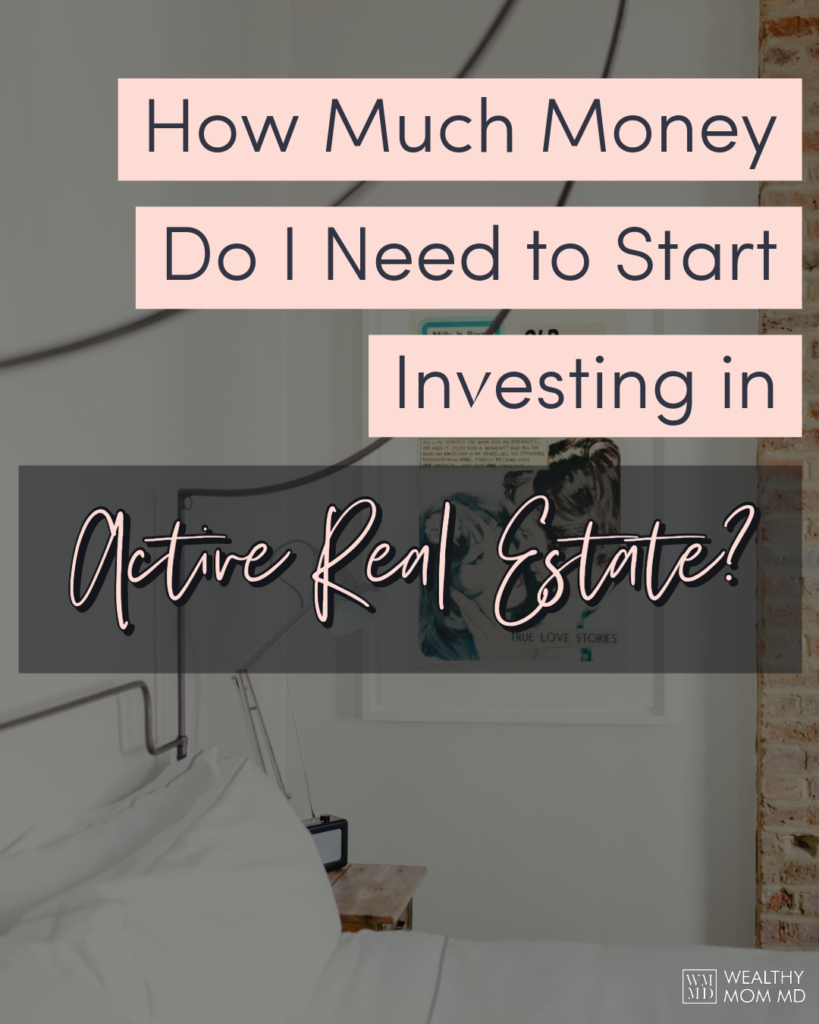
I only have $50,000… What are my options?
If you only have $50,000, you actually have a number of options to start investing in the cashflowing rentals (note I’m excluding passive modes of real estate investing including syndication and debt funds in this article).
One of the best options is to Buy, Rehab, Rent, Refinance or BRRRR a property. This is an attractive model because you can do this with no money down. BRRRR stands for buy, rent, rehab, refinance and repeat. The goal of the BRRRR strategy is to get all your money out of a property quickly and re-use it for future purchases. The key with this strategy is that you must buy a property in need of rehab at a below-market price. You buy the property with your $50,000 cash. You then rehab the property and rent it out. A bank then uses the new rent to establish the value of the property, which allows you to walk away with significant equity and all your initially invested money back in your pocket. When you successfully BRRRR, you have infinite cash-on-cash return.
A second option is to do something called “house hack.” If you use this strategy, you can buy a multi-family property with very little money down using an FHA loan. With an FHA loan, you have to live in the property (and rent out the other units) to qualify for their low money down program (only 3.5%). House hacking allows you to buy a much larger property than you would otherwise be able to afford and to be able to pay minimal rent or live rent-free in your unit, saving money for a second purchase.
The third option is a standard purchase, putting down 25% down on a $200,000 multifamily property. Depending on your market, you could buy between 2-4 units with that amount.
I’ve bought myself a standard duplex, now what?
In this case, if you collected 10% cash-on-cash on your duplex deal, you’d be making $5,000 in cashflow a year plus having your renters pay down $2,500 per year on your loan. It may not seem like you’ve done much to change your situation.
But you have.
Because this is when you roll up your sleeves and get to work increasing the duplex’s worth so you can trade it up to a bigger property…soon.
How do you add value to your duplex with little to no money?
First, you can increase rents. When we look for something we call “hidden value” in investment properties, one of the most frequent things we see is under-market rents. Ideally, what you’ve bought is a $200,000 duplex that was renting for $1800 a month, but should actually be renting for $2100 a month ($300 added rent per month).
Other sources that you may be able to tap to increase the income of your property without or with minimal cost include renting out storage units, detached garages, adding pet rent, charging for reserved parking spots and adding in coin laundry. Let’s say you increase rents by $100 a month here.
The second thing you can do to increase the value of your property is to lower expenses. You can do this with no cost to yourself by billing back utilities or giving your tenants responsibility for landscaping costs. Let’s say you save $200 a month in utilities here.
Let’s say you do all that year one of owning the property. And, as a result, you’ve added $600 a month to rent – and approximately $120,000 of value to your property. While that may seem like a lot, it’s actually fairly easy to add this kind of value if you’ve bought a property right in the first place.
Now your $200,000 purchase is worth $320,000. After one year you could get an appraisal and take out money to buy a second property. Or you could sell this property and roll it into a bigger one.
But, for the sake of this model, let’s say you keep it.
It’s year two…
Now, the second year of owning the property, you put $50,000 in to rehab it.
Maybe you add an extra bedroom or unit. Maybe you lower maintenance costs and increase rent by putting in flooring instead of carpeting, adding nice grade finishes in the kitchen, repainting and fixing up the bathrooms.
What this $50,000 rehab does is result in much higher rents (you get >10% return on investment for your rehab), and it adds value to your property, like I showed you increasing income and decreasing expenses did above.
This is called forcing appreciation.
The value of multifamily properties is based on their net operating income (income minus expenses). When you increase income (by raising under-market rents or do rehab that results in higher rents for example) you, increase the value of the property by a multiplier. Although this multiplier is different in each market, for the sake of this example, we’ve chosen a very reasonable multiplier: for every $30 dollars of increased rent per month, you raise the property value by $6,000 (CAP rate of 6 for those of you who have real estate experience).
So, in this case, as a result of your rehab, you increase rents by $400 a month, resulting in $80,000 in value. Not only that, your rehab was also a tax write-off (though it resulted in a passive loss, which isn’t as useful as an active loss, as you’ll see below).
Now you decide to sell!
You sell your $200,000 purchase for $400,000 using a 1031 exchange, so you can do it in a tax-deferred way. Again, this may seem crazy, but we’ve done this exact scenario multiple times.
You now have about $250,000 to roll into your next property using (yes, I didn’t count selling costs here, but I also left out the cashflow you made while you owned the property and the equity pay down by your renters during the time you owned your property too).
What’s next?
For the sake of simplicity, let’s say you go bigger and just buy one property. $250,000 down will buy you an $830,000 property if you put 30% down (needed for many commercial loans). Let’s say you buy a 12-plex with this money. Your cashflow becomes $25,000 each year (tax-free!).
And now you claim real estate professional tax status.
What is real estate professional tax status?
Real estate professional tax status is a tax status that you can claim if you meet two criteria. First, you must do the majority of your working time on real estate. If you or your spouse doesn’t have a W2 job or you work part-time, this can be a fairly easy criteria to meet. Second, you need to spend a minimum of 750 hours on real estate investing each year (with at least 500 of those hours being spent on material participation on your own properties).
You can read more about real estate professional status here.
Now that you own 12 units, it’s likely that you (or your spouse) are going to meet criteria, especially if you are doing significant work on your property such as self-managing it, overseeing a rehab or visiting the site or managing your property managers.
So what does real estate professional tax status get you?
Now all of your paper losses on that property can become active losses on your taxes, sheltering your clinical or other W2 income. So now you can write off massive losses from bonus depreciation and rehabs, reducing or even eliminate your income taxes.
Having real estate professional tax status has saved us six-figures in taxes every single year. You can imagine what that does to your growth.
Therefore, the next year, you buy a new duplex with your tax savings alone. And now you’re that much closer to financial freedom.
Can you see how even a small amount of money invested in real estate can get you to financial freedom?
Real estate investing can seem overwhelming to people. They don’t know where to start.
But, as you’ve now seen, a fortune can start with just one small purchase. The key is buying the right property at the right price and knowing how to harvest hidden value and force appreciation. And then achieve real estate professional tax status quickly.
So how can you make sure you get the right property, a property that will get you that much closer to financial freedom?
You must become an educated investor. That involves not only gaining knowledge, but also finding yourself a mentor to help you avoid mistakes and a community of like-minded investors who will hold you to a higher standard.
When you have these three ingredients, there’s no limit to what you can accomplish.
Ready to start? Check out Semi-Retired MD’s FREE introductory video course.
Read MoreWelcome to another installment of Interviews with Real Female Physicians. The goal of this series is to share their story so that you, the reader, may learn and be inspired by their experiences – good and bad. We all come from different backgrounds and have different situations. Some of you are married, some are not, some with kids, some with blended families. Let’s show other women that any of these can work financially!
Tell us about yourself:
My name is Harriet Hopf. I’m an anesthesiologist and professor at the University of Utah in Salt Lake City, UT. I have been married for 31 years to Leo, a self-employed management consultant, author, and educator who focuses on strategy and decision-making. We have one child, E McKinley, who recently graduated from Colby College in Maine with a BA in American Studies, is back home coaching volleyball and applying to graduate school, and has a passion for justice and educating their peers about sexuality and health. We love sports: we have season tickets to the Utah Jazz NBA team and U of U women’s volleyball, basketball, and gymnastics, and men’s football and lacrosse, and I served on the Athletics Advisory Council at the University of Utah for six years. When we aren’t being spectators, we love hiking, biking, and snowshoeing in the spectacular landscapes of Utah; dance; music; and travel.
I grew up in New Hampshire. I met my husband at an intramural volleyball game between the business school and the medical school. I knew he was the guy for me when I smashed the ball in his face and that inspired him to ask me out. I completed anesthesiology training at the University of California, San Francisco, including research fellowship, in 1992, and was on the faculty there for 14 years before moving to the University of Utah in 2006.
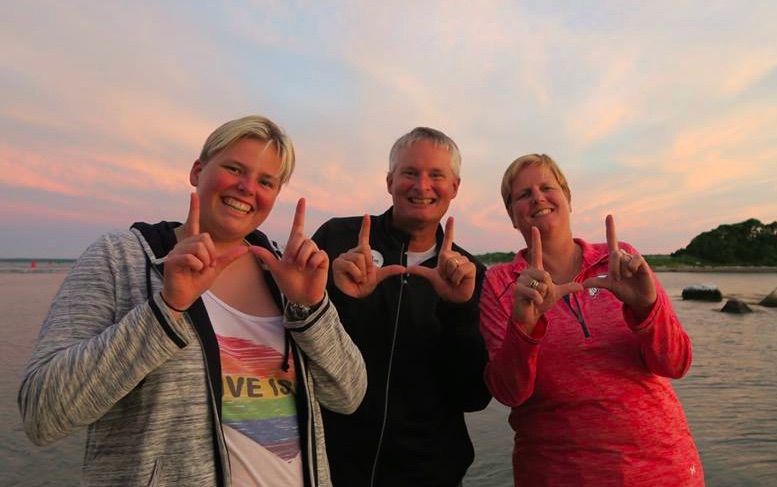
I love my specialty, although it took me a while to figure that out. I matched in surgery but realized quickly it wasn’t right for me. After internship, I went to a surgery lab at UCSF to study oxygen and wound healing. I quickly realized that anesthesiologists hold a key to preventing surgical site infections through managing patient physiology, so I made the jump to anesthesiology residency. It was only on the first day I realized the many reasons I had made the right choice: 1) anesthesiologists monitor everything, so there’s immense opportunity to understand what is going on with a patient, as well as to see the immediate impact of interventions; 2) I love invasive procedures and was worried I would lose that in leaving surgery, but anesthesia procedures, including vascular access, peripheral nerve blocks, and neuraxial blocks, often require a much higher level of creativity (finding a vein when none is visible, or finding the epidural space by feel and loss of resistance, for example) and thus I enjoy them more; 3) patient interactions, though brief, are high stakes: I have to gain a patient’s trust when they are frightened and often overwhelmed; 4) when I’m working clinically, it is intense and requires my full focus; when I have a non-clinical day, there is virtually no chance I will get called to the operating room. I love both the intensity of practice and the ability to protect time for other pursuits (research, education, administration). For medical students considering anesthesiology, it’s good to like planning and preparation, and also making quick decisions in a crisis; in fact, much of our training is learning how to make the right decisions in a crisis. You have to be good at managing a team and leading when you are not “in charge.” The better we do our job, the less we are noticed. For some, that is uncomfortable, but I happen to enjoy the challenge.
Did you graduate with student loans?
I grew up in the one state (NH) that has neither a state medical school nor an agreement with another state medical school, so I attended the closest thing to a state school for me: Dartmouth, where tuition and fees were, of course, higher than at a state school. My state loaned me $10,000 for my education, with no interest until I finished training, then at 7% interest. For context, HEAL loans had an interest rate of 19% at the time, so it was a great deal. I received very generous scholarships during medical school, which helped immensely, and which is why I donate to the scholarship fund every year. I was parsimonious and lived on $3000 less than they thought I should (the contribution “expected” from my parents), in an unfinished basement apartment my husband (then boyfriend) and his business school friends called the Hobbit Hole. I graduated with $130,000 in debt (1986 dollars), a combination of GSL loans at 7% (including those from college; no-interest until I finished training and I went to med school immediately after college graduation), Dartmouth’s version of HEAL loans at 12% compounded immediately, and the state loan.
How fast (or not) are you paying them off and how are you paying them off?
We paid off all our loans (my husband’s $30,000 from business school plus mine) 7 years after graduation. As an intern, before we were married, I was paid a princely $20,000. Because this was before work hours rules (100-140 hour weeks at my program), I didn’t have time to spend money and I managed to pay $100 more than the interest each month on my HEAL loans. Leo and I were in different states at the time. When I moved to San Francisco after internship, we moved in together (and married a year later). At that point, we chose to use all of my income (which increased to $35,000 a year) and half of his to pay off loans. Our life-style got better every year, since Leo got a raise each year at his consulting job, which was better paid than residency. Once we had paid off the loans (a year after I completed training; at that point, my faculty salary was $130,000 a year), we continued that model for a year, which enabled us to save $100,000. We used that money to fund a 14 month trip around the world, plus the down-payment on a house when we returned home. I recognize how fortunate I was to 1) go directly to medical school, 2) find a partner who also had a good income, and 3) have the option to delay having a child.
Financial aspects of kids
When did you have them?
We had our child 6 years after I finished training, 10 years after we got married, and 6 months before I submitted my promotion file. We chose to delay having kids, mostly so we could go on our big trip. We thought we would want more than one child, but the family unit just felt right, so we stopped at one.

Are you planning to fund their college expenses?
We were fortunate that Leo’s mother made yearly contributions to a 529 for her grandchildren, starting when they were born. We also contributed. The 529 covered the first 3 years (with child expected to earn enough to cover personal expenses). We are fortunate to have the means to cover the 4th. The kid was offered scholarships at many schools, but chose one that did not offer scholarships- we were fortunate to be in a position to allow that choice. We had a lot of discussion on this topic. My husband went to state school and paid his own way. I went to a private liberal arts college and my parents paid tuition, room, and board for me, except for the GSL loans I took out that covered about 25%; part of the funds came from their benefits as college professors. The reality now is that the ratio between what a college student can earn and what they have to pay for tuition is sadly out of whack and substantially higher than when we went to college. I’m glad our kid was able to focus on school and not finances. And I’m acutely aware of the extent of our privilege to be able to do that.
What were your childcare expenses?
We had a full-time nanny until our kid was in middle school, and then had a part-time nanny, mostly for transportation. We chose that because of my work hours (early and late), the fact that both my husband and I travel a lot, and the fact that sick kids can’t go to most day-cares. It worked well for us. We paid at the high end of going rates (privilege, again), salaried at more hours than they actually worked (which gave both flexibility and loyalty), and provided health insurance and 3 weeks of paid vacation.
Was your child in private or public school?
Our child attended a Montessori school for kindergarten. They attended public school for 1st-3rd grade in CA, where we contributed ~$4000 / year to fund PE, music, and computer education because they were not covered by state funds. When we moved to Utah, they attended a private, independent school which cost ~$15,000 annually.
Financial aspects of marriage
Did you get a pre-nuptial or post-nuptial agreement?
We had a pre-nuptial agreement that stated that neither one of us had any assets and that one of us helping with the other one’s loan repayment did not constitute an agreement to continue to pay if we got divorced. It was drawn up by one of my recreation basketball teammates who was a lawyer and did it for free. We burned the agreement the day we paid off our loans, 5 years into our marriage.

Do you and your partner agree on finances?
Generally, yes. My husband has an MBA, so he has taken the lead on finance. Both of us hate debt, so it was easy to agree to our arrangement to live on half his salary to get the loans paid off. When we moved in together, we had separate bank accounts. We calculated our monthly costs and each contributed monthly (on a sliding scale by income) to a joint account that we used to pay the bills. We continued that until we had been married about 5 years, when we both felt comfortable doing everything as a joint account.
Early on, we agreed on a “spending limit,” the amount either one of us could spend without consulting the other. At the beginning, it was in the range of $50 and has risen over time to $500. When my husband was in a consulting firm, he got annual bonuses. One of the best things we ever did was to contribute 5% of the bonus to an individual account (in the range of $2000 a year) for each of us. This is money we can spend however we want, without input or judgment from the other. This prevented a lot of uncomfortable discussions about expensive camera equipment or paying for travel for family members, for example. Once he went out on his own, it was based on his income for the year.
My husband also made me contribute to 403b/401k starting as an intern, for which I am grateful. I didn’t know what they were and thought I couldn’t afford it, but he pointed out that pre-tax donations cost almost nothing and early contributions to retirement accounts have the most impact on retirement income.
Are you the breadwinner?
We are dual breadwinners, although I have only out-earned my husband once in 31 years. On the other hand, it is my health insurance and steady income that allowed him to go out on his own 16 years ago.
Financial mistakes:
What financial mistakes have you made?
When I was a 4th-year medical student, Leo was appalled to learn that my car insurance deductible was only $100. He made me read “The Only Investment Guide You’ll Ever Need” by Andrew Tobias (which everyone should) and raise it to $1000. The day I did, my mother borrowed my car and was in an accident ($2700 damage, all to the car, none to her or the other driver). The good news? The deductible change didn't go into effect until the next day.
General Finances
Who handles the finances in your relationship? Do you DIY or do you have a financial advisor?
My husband has an MBA, so he generally handles the finances, but we discuss all decisions and all assets are in a joint trust we created before our child was born. We were DIY until our finances became complicated by things like start-up investments and a child. We are mutual fund investors and don’t play the markets. We have paid cash for each of our cars, which we tend to own for a long time, including one of our current cars, which is 21 years old and has 215,000 miles on it. We just paid off our home loan, 12 years after buying the house. These habits, plus living in a cheap apartment and not buying furniture until we were 35, plus buying a house in the Bay Area in 1995 and selling it in 2006 at more than twice what we paid for it, have allowed us to not have to worry much about our finances.
How are you saving for FI/retirement?
I have a 403(b) to which I have always contributed the maximum and a 14.2% defined contribution retirement plan through my work. I rolled my UCSF retirement accounts over into Roth IRAs, where we have put the rest of our retirement savings as well. We invest in index funds with a fairly conservative allocation which we re-evaluate annually but change very little. We have a house with no mortgage. We have enough to retire when we want to.
Do you have insurance?
We both have long term disability insurance, and mine is specific for my specialty. We both have life insurance, a large amount of term that expires a few years after we retire and a modest amount of whole. We also have long-term care insurance. We just reassessed all of our insurance and created a new will after E turned in January.
Have you had to use (long term) disability insurance?
I’m particularly grateful right now for the specialty-specific long-term insurance. I have bilateral basal thumb arthritis that became so bad in July I had to step out of my clinical practice. I had a tendon transfer and MCP release on my left thumb in August and I’m scheduled to have the right thumb surgery in February. Thus, I’m on what is likely to be a year-long hiatus from clinical practice. Although I can continue to work full time as a professor, most of my salary comes from clinical practice. Our finances are such that we’d be okay with only my base salary, but it’s nice to have at least a percentage of my clinical salary as well.
If you are FI or “retired” – what are you doing?
I’d call us FI. We spent very little early on and paid off our school loans quickly. Once they were paid off, and given we had two good incomes, we were able to spend more freely and focus on retirement funding. We just assessed our total assets as we re-did our will, and the retirement funds are much larger than we had realized. I hit 59 ½ years old on Thanksgiving day, so we can now access our retirement accounts if we need to. We continue to work because we both have jobs we love. It’s nice to know we can retire when we want to, though. And it’s fun to consider what the next chapter will look like, even though it is a few years off.

Do you give to charity?
I give to a number of charities annually, as does my husband, and we make some donations jointly. For my undergraduate college, I give to the general fund and to the basketball program, in gratitude for the impact they had on my life. I give to the scholarship fund for my medical school, to pay it forward. I donate to the Executive Leadership in Academic Medicine program at Drexel University to support leadership education for women in the health sciences, in gratitude for the impact the program has had in my life. I donate to the Foundation for Anesthesia Education and Research because of the important contributions they make to developing future clinician-scientists and advancing my field. I donate to several environmental and civil rights groups. We provide support to two local, innovative dance companies, the Utah Symphony, and the University of Utah College of Fine Arts, because of the importance of the arts in society. We donate to the University of Utah general fund, specific initiatives, and in support of women’s athletics generally and the volleyball team specifically.
Any parting words of wisdom?
Choose your life partner (if any) wisely. In particular, make sure they are enthusiastic about your success and are willing to be equal partners. If possible, try to find someone who is not in medicine. Your conversations will be more interesting and they will stretch you to see and experience the world in different ways. My strategy and decision-making guru has been a remarkable peer mentor, even though my personal style of decision-making runs to the intuitive.
Tell readers a fun/random fact about you:
I played 3 sports in college: basketball, softball, and track. I was a walk-on in all three sports (different era!). I was a starter in basketball as a junior/senior, in softball as a senior, and set the high jump record in my first year.
And finally, where can people connect with you?
Twitter: @HarrietHopfMD
Read MoreDisclaimer: Please note that some of the links below are affiliate links. This means that I may receive a commission if you purchase through one of my links. I highly recommend all of the products & services because they are companies that I have found to be helpful and trustworthy. I use many of these products & services myself.
Got loans? You’re not alone! Most doctors are finishing medical school with student loan debt well into the 6 figures. Add a few years of capitalized interest during residency and you can really find yourself in the deep end. According to NerdWallet, the average student loan debt for medical students is upwards of $196,000. Yikes!
So, what should you do?
The first fork in the road is to determine whether you’ll be pursuing some sort of loan forgiveness program such as Public Service Loan Forgiveness. Let’s take a look.
Pursuing the Public Service Loan Forgiveness Program
Of course, not having to pay back some, if not most, of your student loans would be the ideal circumstance, but unfortunately there’s a few extra steps than that.
It can get extremely complicated if you don’t do your research to make sure you meet the qualifications:
- You must have Direct Loans
- You must work for a 501(c)(3) employer or work for the government (VA). Virtually all residency programs are 501(c)(3).
- You must sign up for an income-driven repayment plan ranging from 10-20% of your income. PAYE or REPAYE are the best options for most folks.
- You must submit paperwork at least annually
All of the income-driven repayment plans also have their own sort of built-in loan forgiveness programs outside the PSLF, in case you don’t qualify for it. For a complete list of loan forgiveness programs, check out Student Loan Hero’s comprehensive list. For an in-depth look at the PSLF program, check out Student Loan Planner’s detailed guide. Or, if you’re like me and prefer to have an expert help you figure this all out, contact my friend Travis Hornsby of Student Loan Planner.
The rest of this guide will assume you’ve decided to refinance your loans.

Refinancing Your Loans
Refinancing your student loans works a lot like refinancing your mortgage: switching your current loan provider for one with a much lower interest rate, saving you thousands of dollars in interest. The good news: no closing costs!
The only downside is that if you refinance federal student loans, you lose access to federal benefits like loan forgiveness, but many lenders offer loan forbearance, unemployment protection, and/or loan forgiveness at death–so if you go the refinancing route, make sure you research a lender’s benefits thoroughly before selecting.
Honestly, the pros outweigh the cons when it comes to refinancing. You’ll save a lot of money and you can refinance again if you find a lower rate. For those concerned about loans not being forgiven if you die or become disabled, simply purchase enough term life insurance and ensure you have adequate long term disability insurance. Thankfully, many of the refinancing companies do offer some sort of reprieve from both.
Factors that help you get a lower interest rate:
- Current market rates, such as LIBOR
- Your credit score: most lenders are looking for a score in the mid to high 600s.
- Work experience: be sure to include your time in residency–it counts!
- Applying with a cosigner: you’re more likely to get approved with a qualified co-signer, meaning they have a good credit profile.
- Your debt to income ratio: the lower your debt-to-income ratio, the better.
- Applying with multiple lenders: that way, you can compare rates and maximize your chances of getting approved.
- Loan terms: interest rates are generally higher for longer terms
- Fixed vs. variable: Variable rates will be lower but they have the potential to increase over time. If you plan to crush your loans pretty quickly, I recommend choosing variable.
Top (5) Tips to Pay Off Student Loans
- Live like a resident! One of the biggest mistakes physicians make is to increase their spending in proportion to their pay increase once they get out of residency.
- Make a visual representation. Whether it’s an Excel spreadsheet or a physical chart on the wall, it really helps to have a visual to keep track of your progress and motivate you to keep going.
- Refinance those loans! See our recommended list here and get some awesome cash back bonuses!
- Don’t be afraid to refinance again. If rates go down, there is no penalty (fees) for refinancing again.
- Use the debt snowball method to pay those loans down.
Until 12/15/19, Wealthy Mom MD has a special offer for our readers when you refinance with SoFi: an additional 0.25% off your rate. Enroll in auto-pay and receive a total of 0.5% off your rate!
In time, and with a little savvy, you can tackle those student loans and live debt-free! I know you can do it, like so many others before you! You’ve got this!
Read MoreAs a working mom, you’re looking to build wealth for yourself and for your family. You’ve likely heard over and over again that real estate is one of the most effective ways to do that. However, if you’re anything like I was, you are probably unsure where to start. Understanding how real estate debt funds work can help you determine if passive real estate investing is right for you. If it is, we’ll even guide you to resources to get started with real estate debt funds.
The Basics of Real Estate Debt Funds
If you’re new to the concept of real estate investing, there’s a good chance you haven’t yet heard of debt funds. A good way to think of debt funds is to think of them as the bonds of the real estate world, whereas buying property is akin to purchasing stocks. The comparison holds, but it is also worth noting that debt funds won’t be as predictable as government bonds.
After the 2008 crash, real estate debt funds started to increase in popularity. While the number of people involved in funds is growing, it is still a niche part of real estate investing.
A debt fund typically aims to connect a borrower, who is usually a project developer, with access to short-term capital. They use this funding for large-scale projects, such as shopping malls and apartment complexes. Periodic payments are made to investors from interest and security charged against the loan and the assets respectively.
Things to Note About Debt Funds
Building wealth isn’t simply about growing income. Understanding how money is taxed is an important pillar of growing wealth. As such, it is necessary to know how debt funds are taxed. If you generate income through a debt fund payout, it will be taxed like ordinary income.
Building wealth isn’t simply about growing income. Click To TweetTo shelter that income, you need to open a self-directed IRA, or SDIRA. You need a special self-directed custodian or provider to fund an SDIRA. When choosing a provider, it is important to research the different costs you may incur and how much support you’ll receive from the provider. Check out all the details of self-directed IRAs here.
How I Got Started in Real Estate
Originally, I brushed off the idea of real estate investing. It seemed like it would be complicated and require more time than I wanted to expend. Instead, I chose to laser focus on paying down my loans. Eventually, though, I realized that real estate investing doesn’t have to be overly complex. Plus, it can certainly be passive.
When I decided to grow my wealth with real estate, I used real estate syndications to get started. Real estate syndications are powerful investments that can help you build wealth. Let’s take a deeper dive into syndications to see how they might fit into your investment portfolio.
What Are Real Estate Syndications?
Often times, people are turned off to the idea of investing simply because of the terminology involved. That makes sense. When it sounds like someone is speaking a foreign language, of course, your confidence might start to wane. To understand how real estate syndications work, let’s start by breaking down several key terms:
Syndicate
When a group of investors pool their money, a syndicate is formed. This syndicate uses the pool of money to purchase real estate. Since the money is pulled from multiple people or groups, real estate can be purchased on a much larger scale compared to what an individual investor could likely purchase.
Commercial Real Estate
Syndicates often purchase commercial real estate. Rather than buying residential real estate, such as a single-family home, commercial real estate is a much larger investment, not just in terms of the price tag but actual size as well. Common commercial real estate syndications might involve senior living facilities, self-storage buildings, and high-rise apartment complexes.
Sponsor
The sponsor is also sometimes called a syndicator. This person or group is responsible for identifying the real estate project and setting up the purchase. They are involved in locating the property and finding investors to support their purchase. In an equity syndication, the sponsors generally put forth up to 20% of the equity.
Investor
If hearing the word investor makes you think of someone who is glued to a stock ticker, rest assured that is not the only type of investor in the finance world. In syndications, investors are passive investors. That means that the investors contribute the funds, but the active work related to the real estate project is handled by the project sponsor. Remember that in order for it to be a syndication, there is a group, or pool, of investors backing the project.

A Closer Look at Real Estate Syndications
In short, a real estate syndication is a deal between a group of investors and a sponsor that allows a group of investors to purchase a real estate project that they wouldn’t have access to on their own. Because it is a type of passive real estate, investors don’t have to worry about having the time or experience that is required in active real estate investing.
Until 2012, real estate syndications were not talked about much. Why? Public advertising was actually prohibited until the JOBS Act of 2012 relaxed some of the rules around syndications. One of the most important criteria that still stands is that syndication investors must be accredited.
To be an accredited investor, you will need to make at least $200,000 a year as an individual or $300,000 as a married couple. You also need to have earned this level of income within the last two years. Another way to have accredited investor status is to have at least $1 million in net worth outside of your primary residence.
Most syndications require between $25,000 and $100,000 to start investing, However, some may allow you to buy in with $10,000. In addition to having the money to buy into the syndication, you will also be asked about accredited investor status.
What Are Equity Syndications?
When you invest in an equity syndication, you aren’t just a lender; you become an owner as well. That is because investors in equity syndications are granted partial ownership of the project. That means that you are not only entitled to a return on your loan, but you can also receive a portion of the profit when the real estate project is resold or refinanced. It is worth noting that equity projects tend to take longer to complete. A ballpark range of at least 2-3 years should be helpful when determining if this type of investment is right for you.
What Are Debt Syndications?
Debt syndications will have you harkening back to your Monopoly days because you and your fellow investors become the bank. Approved borrowers can access your pool of funds to complete their real estate projects. Throughout the length of the project–usually 18 months or less–each investor receives monthly dividend checks for pre-determined amounts as the borrower repays the loan. Unlike equity syndications, investors in debt syndications do not have any ownership rights. However, your investment is protected in that you have the right to foreclose should the borrower default on their repayments.
What Are The Big Differences Between Equity and Debt Syndication?
One of the biggest differences between equity and debt syndications is how they make money. Both syndicates earn money on the loan interest and the fees. However, only equity syndicates earn money when the property is (re)sold or refinanced.
Another major difference between the two types of syndication is in regards to ownership. In an equity syndicate, each member possesses partial ownership. That means that they have both shared ownership and shared liability. On the other hand, members of a debt syndicate do not actually have any ownership, so they have no liability risk either.
Returns are a third distinguishing factor between equity and debt syndication types. In order to receive final returns on an equity syndicate, the project has to increase in value, whereas debt syndicates are entitled to the return regardless.
Getting Started with Debt Funds & Syndications
The idea of getting started with real estate can be daunting. It’s important to remember that real estate isn’t always about rolling up your sleeves to flip properties or being on-call around the clock as a landlord. Passive real estate opportunities, such as syndications, exist, and they can be great tools to generate wealth even while you sleep.
If you’re ready to take the next step passive real estate investing, check out Dr. Peter Kim’s Passive Real Estate Academy. In this 4 week online course he will teach you everything you need to know to vet and analyze a syndication deal so you can be confident investing in it. It only runs a few times a year. As a special bonus to my readers, if you purchase through me, you will receive some timely bonuses. I announce them as the course date approaches, so stay tuned!
Disclaimer: Please note that some of the links below are affiliate links. This means that I may receive a commission if you purchase through one of my links. I highly recommend all of the products & services because they are companies that I have found to be helpful and trustworthy. I use many of these products & services myself.
If you’re looking to grow wealth, real estate should be part of your plan. Not convinced? Consider that Andrew Carnegie, the author of Think and Grow Rich, once said, “90% of all millionaires became so through owning real estate.” For many people, though, real estate seems too confusing or too much of a time commitment. If that’s the case, you need this overview on real estate to learn how both active and passive real estate might play a role in your overall investment plan.
An Overview of Active and Passive Real Estate
There’s a good chance you’ve heard at least someone in your life (or on this blog!) mention the value of real estate investments. Perhaps you are interested but unsure, or maybe you’ve been avoiding it. What’s more likely, though, is that you don’t currently invest in real estate because you aren’t sure how to get started.
The goal of this real estate overview is to explore enough of the benefits that you feel empowered to explore more. As an added benefit, we’ll take a deeper dive into passive real estate to see how this is something that can fit into your busy life and wealth-building plans.
The Benefits of Real Estate
Whether you’re involved in active or passive real estate, it’s important to understand the benefits. Here is a general overview of four of the greatest benefits of investing in real estate.
Speed
Perhaps the biggest benefit of real estate is the speed at which you can generate income. Real estate allows investors to make money relatively quickly compared to stock market investing. Between waiting for returns to compound and paying taxes, growing wealth through the stock market takes time. Real estate, on the other hand, can pay off much quicker.
Taxes
Some traditional stock market investments can be tax sheltered, but there’s no getting around the fact that you may pay quite a bit in taxes on your investments. Conversely, you reap the best and most tax benefits as a real estate investor. This is especially true if you achieve real estate professional status. Here’s a secret–the tax code is written for real estate investors and generally “punishes” employees.
Familiarity
Another important consideration to make when getting started with real estate investing is the fact that you’re already familiar with it. Even if you rent your home now, you’ve still encountered the notion of home ownership. Because there are so many different types of real estate–more on that in a bit!–if you’ve actually lived in different dwellings, you have even more familiarity with this type of investing than you probably realize.
Tangible asset
Finally, real estate is a tangible asset. You can see the property that you own. This is vastly different than numbers on a screen that relate to shares of a company that you might own via the stock market. For some people, the fact that this is a tangible asset actually makes people feel more confident.
How Real Estate Makes You Money
There are several different ways that real estate makes you money. When you’re deciding between active and passive real estate (or maybe considering doing some of both), it’s important to have at least a surface-level understanding of how wealth is generated.
- Cash flow – If you own direct real estate, and the rent you are paid is more than your mortgage and other expenses, you’ve created cash flow.
- Appreciation – Generally speaking, real estate appreciates over time. That means that the value of your investment should hopefully continue to increase.
- Tax benefits – There are numerous tax benefits, such as the real estate professional status, that are only afforded to real estate investors.
- Leverage – Someone who is leveraging is using borrowed money to make more money. This is a novel concept to many since many of us would not otherwise consider taking on debt to make money.

Types of Real Estate
Houses are probably the most common type of real estate that people think of. However, there are actually many types of real estate you can invest in.
Some types of real estate include:
- Raw land
- Single-family homes (this is the traditional home that you probably live in now)
- Multiple-family homes, such as duplexes or triplexes
- Apartment complexes
- Mobile homes
- Commercial real estate
- Self-storage facilities
Equity and Debt Investing
You can think of real estate investing in two ways: equity and debt. By understanding the two ways that you can invest in real estate, you’ll be a much more informed investor.
Equity
An equity investment in real estate is when you own the property. This can take on many different forms. In the case of direct ownership, you own the property that you then rent out.
Additionally, you can also invest in syndications, crowdfunding, or real estate investment trusts (REITs). When done in this manner, investors profit from the promised interest return and then again with a share of the profit when the properties are sold.
Debt
If you’re familiar with how bonds work, you can think of debt investing in real estate as something similar to that. You lend money to another person or entity so that they can buy real estate. As an investor, you will typically receive monthly interest payments. These interest rates can be quite high, especially compared to bonds. After a period of time, usually a year, your capital is then returned. The high interest rates plus the fact that they are simple and relatively secure make debt investing powerful.
It is important to remember that debt investing is taxed as ordinary income. The only exception to that would be if you are buying them inside a tax-advantaged account. To do that, you would need to set up a self-directed IRA. By creating a self-directed IRA, the account custodians will then allow you to invest in a debt fund, and the money in the account is tax sheltered.
Looking at the Spectrum: From Active to Passive Real Estate
Direct ownership is the most active type of real estate investing. For some people, the fact that direct ownership also comes with the most tax benefits thanks to that real estate professional status is enough to justify the work that often goes into direct ownership.
However, there is a good chance that you’re looking to build more passive streams of income. Whether you are thinking of real estate as a side hustle, a secondary income stream, or even an opportunity to downshift from your full-time medical practice, it’s important to understand the more passive options.
Turnkey real estate is less work than direct ownership but you still fully own the property. In this process, an investor is still buying and possibly rehabbing a property, but they use a third-party to make it more hands-off.
Even more passive than turnkey real estate are syndications. Syndications pool funds from a group of investors into various real estate projects, generally projects that a single investor would not be able to buy on their own (think multi-million dollar projects).
Finally, crowd-funding and real estate funds are the most passive types of real estate investing. You should know that they are the most passive, and they also come with the fewest tax benefits.
A Deeper Dive into Passive Investing
The idea of diversifying your portfolio with real estate sounds appealing to most people. However, it’s true that active real estate can sometimes feel like another full-time job. If you want something more hands-off, you’ll want to explore some of the more passive real estate investing options.
Crowdfunding
If you’re familiar with the concept of crowdfunding in terms of ideas or products (think Kickstarter), you already have an understanding of how crowdfunding real estate works. Crowdfunding real estate is fairly new, at least in a formal capacity. However, investors have been pooling funds for centuries.
In crowdfunding real estate, investors combine their resources to invest in any variety of real estate projects. Online platforms streamline the crowdfunding process further. That way, investors can bypass the parts of active real estate–working with agents, brokers, and contractors–that can be so time consuming.
Real estate crowdfunding can involve both debt and equity deals.
Syndications
Recall that a real estate syndication pulls together funding from multiple investors. This pool is then used to purchase a larger real estate project. Typically, the investments including properties like high-rise apartment buildings, assisted living facilities, or self-storage centers. By pooling money together, the expenses are shared and the risk is split.
REITs
A real estate investment trust, also known as a REIT, is another form of passive real estate investing. Generally, the trust purchases a property and rents the space. The income that is generated from the rental is returned to shareholders in the form of dividends. You can purchase shares of a REIT through a brokerage, like Vanguard or Fidelity.
Final Thoughts on Active and Passive Real Estate
You aren’t likely to become an expert investor after reading one blog post. But consider working through this overview of active and passive real estate a crucial first step to growing wealth via real estate. Next week, I’ll go more in depth about syndications.
If you’re ready to take the next step with passive real estate investing, check out Dr. Peter Kim’s Passive Real Estate Academy. In this 4 week online course he will teach you everything you need to know to vet and analyze a syndication deal so you can be confident investing in it. As a special bonus to my readers, if you purchase through me, you will receive two books: Rich Dad, Poor Dad by Robert Kiyosaki and How to Invest in Real Estate: The Ultimate Beginner’s Guide to Getting Started by Bigger Pockets.
Disclaimer: Please note that some of the links below are affiliate links. This means that I may receive a commission if you purchase through one of my links. I highly recommend all of the products & services because they are companies that I have found to be helpful and trustworthy. I use many of these products & services myself.
Read MoreNew! Once a quarter or so, I’ll write a behind the scenes type post about my business. I know many of you are entrepreneurial.

In all aspects of life, mentorship is important and when it comes to business, I would say it’s paramount to have mentors. Whether it’s direct mentorship or someone to learn from, from afar.
This post is timely as a month ago I was at FinCon 2019 and just returned from Amy Porterfield’s Entrepreneur Experience. FinCon is the annual conference for financial bloggers, coaches and advisors. There are keynote talks and mini sessions but the main reason we all go is to meet people “in real life” and network. This was my second FinCon. A lot has happened in the past year–it has been a year of immense personal and business growth.
Just prior to last year’s FinCon I started working with a life coach trained by Brooke Castillo. This is when I started what I call my residency in online entrepreneurship.
I went to medical school and residency to learn how to become a doctor. I knew nothing about running an online business or being an entrepreneur. When I saw or read about others doing that, I would always think “Wow, I’m just not like them. I’m not creative.”
I’ve been learning (and still am!) from the following people and what they all have in common is a mindset of growth and abundance and over-delivering in value. For each one, I’ll share their one tip that has helped me to propel myself and my business.
Amy Porterfield
Your online business’s success is tied directly to the energy and size of your email list. List building should always be in the top 3 business priorities.
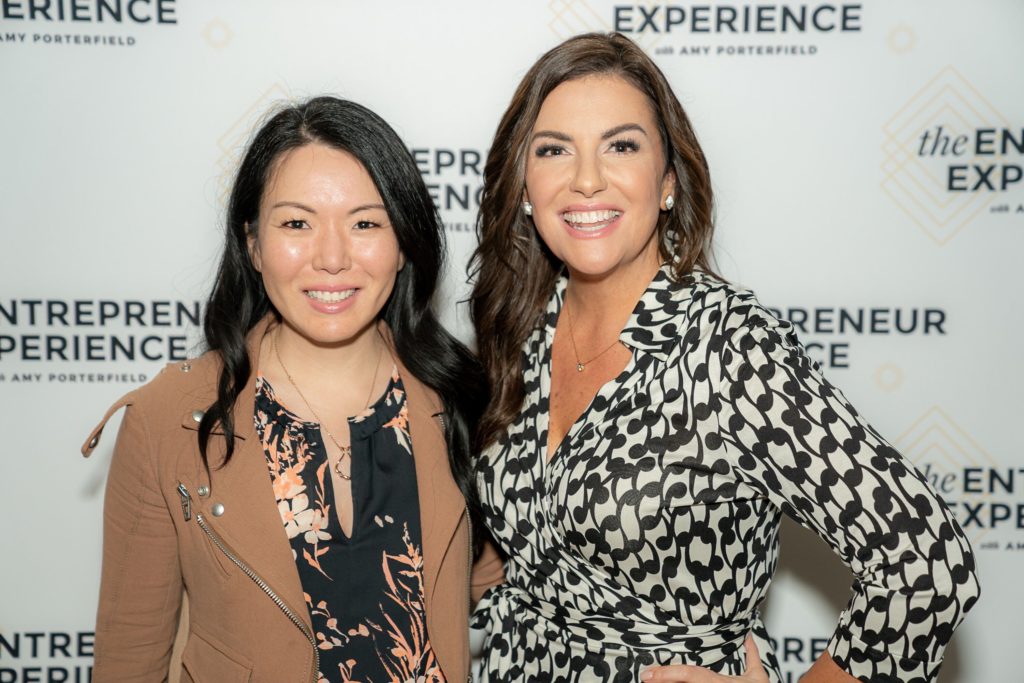
Amy is probably my main and favorite business mentor right now. I’ll be honest, I am not even sure how I stumbled upon her but I am so glad I did! Amy is the queen of digital courses and list building.
She hosts the podcast called Online Marketing Made Easy where she shares her tips for online business success. Her voice has this confidence and authenticity that is hard to match.
I’ve enrolled in almost everything Amy has to offer starting with her List Builder’s Society – a course on how to build your email list. I’ve also bought other people’s courses through her (see below) getting special bonuses only Amy gives. I’ve learned how to organize my business’ assets, how to streamline business communication and build my team.
She encouraged me to hire my integrator (also known as a project manager), an elevated position so I can be free to work on the things that only I can do. Hiring my integrator a few months ago was definitely a leap of faith (and dollars) but I am confident I made the right decision. At some point, you just can’t run every aspect of your business anymore and you need to focus as the visionary and content creator.
And … I just returned from Amy’s live event, The Entrepreneur Experience. Not only did I get to meet Amy “in real life” but I was able to spend time with like-minded entrepreneurs, share struggles and wins in an empowering and safe environment.
Marie Forleo
Everything is Figureoutable!

Yup that’s me and Marie! I had the honor of meeting her on her book tour for “Everything is Figureoutable.” Go get this book now!
I first learned about Marie through Amy Porterfield. Every spring Marie opens the doors to B-School – her widely popular course on how to start and run an online business. Her mission is to help all heart-driven entrepreneurs.
Marie combines Jersey girl sass with some Italian sprinkled in. She has an award-winning show Marie TV in addition to her recent book Everything is Figureoutable.
Stu McClaren
The more money you make, the bigger impact you can have on the world

I learned about Stu through Amy (notice a pattern here?!). Stu is the king of all things monthly membership sites and Amy is the queen of digital courses. Stu and Amy say that courses and memberships go hand in hand like peanut butter and jelly.
He was my favorite speaker at Amy’s Entrepreneur Experience. He infuses passion, energy and comic relief.
He learned early on that there is nothing wrong with making money. He said the more money you make, the more impact you can have on the world. He co-founded Village Impact, a Canadian foundation that builds schools in Kenya. They are working on building a college for budding entrepreneurs. Wealthy Mom MD made a donation to Village Impact which I will talk about in a future blog post.
There will be setbacks and there will be epic “failures.” Success comes to those that persevere and adapt. Click To TweetSummary
Amy, Marie and Stu have guided me this year. Their overarching message to me is to change my relationship to failure. Business is not a straight linear adventure. There will be setbacks and there will be epic “failures.” Success comes to those that persevere and adapt. My ability to handle the highs and the lows and move forward anyway is how I will be successful in business.
As I look ahead in 2020 my focus will naturally shift to learning from Brooke Castillo of The Life Coach School as I finish up my coach certification. I’d love to hear from those of you running a business – who are your mentors and why? Drop me a line here.
Disclaimer: Please note that some of the links below are affiliate links. This means that I may receive a commission if you purchase through one of my links. I highly recommend all of the products & services because they are companies that I have found to be helpful and trustworthy. I use many of these products & services myself.
Read More
This is a repost of last year's financial tips, updated for 2019!
Can you believe the year is almost over? With just a few short months to tie up most financial loose ends, here are some year end financial tips you'll be sure you won't want to miss.
Check out the companion podcast (from 2018) over at the Hippocratic Hustle!
Be Sure To Max Out Tax Advantaged Retirement Accounts
… If that was one of your financial goals.
You may be surprised to learn that we no longer max out all of my available tax advantaged accounts as of this year. Our 2019 goals for tax advantaged retirement accounts were to max out our HSAs and Roth IRAs and get the free match from our employers.
Hopefully you've already set up your work retirement accounts to max out along the year (aka dollar cost averaging). Or better yet, you front loaded them and are done for the year! Here are the accounts you may want to double check:
Work retirement accounts
Work retirement accounts such as 401(k), 403(b), and 457(b) generally have a deadline of by your last paycheck of the year. It can also take 1-2 pay cycles for any changes you make to your contributions–so do this ASAP if you need to increase your contributions. Don't forget to reset this in January unless you want to front load the accounts.
Roth IRA
Don't forget to fund your Roth IRA! Most physicians will need to backdoor it. You do have until Tax Day in April 2020 to fund it, however, it is cleaner if you do the IRA contribution & conversion this calendar year. This is due to how you fill out Form 8606 with your taxes.
Here's the short version of how Form 8606 works: You report the contribution to the traditional IRA on the tax year (2019), but you report the conversion (from traditional IRA to Roth IRA) in the actual year you did it. So for example, if you wait till January 2020 to backdoor for tax year 2019, you'll have to report this transaction on Form 8606 in 2019 and 2020. Not a big deal, but you'll need to keep track of that or make sure your CPA does for you.
Solo-401(k)
Are you self employed or do you have a side hustle? There are two things to know:
- You have until 1/15/20 to contribute your employee contributions.
- Then, you have until tax day April for the employer contributions for the solo-401(k).
If you don't have a solo-401(k) but want to, you have until 12/31/19 to open one – so get on it!
SEP-IRA
If you're a procrastinator, then you'll need to open a SEP-IRA. You have until tax day extension in October 2020 to open and fund one for tax year 2019.
HSA
If you're lucky to have access to a Health Savings Account (HSA) and are using it as a Stealth IRA, you have until Tax Day in April 2020 to fund one. Most folks will fund one via paycheck through work. I self fund it and contributed to it in one lump sum at Lively. Don't forget to invest the money inside the HSA as well. Lively custodies with TD Ameritrade.
Take Advantage of Tax Loss Harvesting
Tax Loss Harvesting (TLH) is a way to capture losses in your taxable or regular brokerage account to reduce your tax burden. The current limit of losses you can claim on your tax return is $3,000. You can carry forward losses > $3,000 to use into future tax returns as well.
Speaking of investments, make sure you know when to rebalance your portfolio. I recommend doing this once a year and definitely not more than twice a year. Pick an annual date to do this.
Be Smart About Charitable Donations
The new Tax Law (as of 2018) makes it more difficult to itemize deductions since the standard deduction is much higher. Hopefully no one donates just for the tax write off. The best way to donate and get a tax break is to lump your donations every other year (or more) so that you are able to itemize deductions.
A great way to do this is to open and fund a Donor Advised Fund (DAF). Why? You take the tax write off the year you contribute to the fund, then you're free to donate to any charity you'd like without having to keep track and save receipts for tax day. You can also donate anonymously very easily via a DAF.
Use FSA Money
Don't forget to use up your Flexible Spending Account(s). Some plans will let you carry forward up to $500 to the following year. However, most of the plans are “use it or lose it.” Your plan can also offer a two and a half month grace period (March 15).
Bottom line – read the fine print of your FSA plan. The same applies for Dependent Care FSA plans. I wonder where the lost money goes – anyone know?
Start or Review Your Estate Planning
There is no end of year deadline for this per se … however this ends up being an non-urgent item on the to-do list for many people.
Create A Will
If you're reading this and you do not have a will – what are you waiting for? Perhaps you elected a legal plan through your employer and the deadline to use it or lose it is coming up. If you are married and/or have children, having a will is a must to elect a guardian in case of your early demise. Otherwise the state will pick for you.
Secure and Safely Share Account Access
Along these lines, if you or your partner passes, do you have access to his/her accounts, logins and passwords? First, you'll want to make sure you have Power Of Attorney. This is not valid upon death but many things can happen where you'll need access to accounts legally.
For password and secure digital document management I recommend a program like Lastpass. For most folks, the family plan will be appropriate. This allows the whole family to use Lastpass to manage passwords. Lastpass can also generate secure passwords (you're not using the same password for all your logins, right?).
You can also use it as a secure digital vault – I upload copies of important documents such as driver's licenses, passports, social security cards, life insurance policies and other insurance policies. I essentially use it as a digital death book.
For those that prefer the paper route for this, check out Mama Fish Save's ICE binder – In Case of Emergency. This is a templated PDF that guides you into documenting all the things you'll want your loved ones to have access to when you pass.
Smart End Of The Year Financial Tips
Make a plan to implement these tips before the end of the year. That way, you'll finish 2019 strong. With only a few short months left in this calendar year, make today the day that you get started.
You can also sign up to grab your guide to the 4 Steps to Creating Wealth. After all, who doesn't want to start the year wealthier?
Read MoreDid you know that you have money beliefs? First, let’s define beliefs:
Belief, noun
1. a state or habit of mind in which trust or confidence is placed in some person or thing
2. something that is accepted, considered to be true, or held as an opinion : something believed
3. conviction of the truth of some statement or the reality of some being or phenomenon especially when based on examination of evidence
Believe, verb
1a. to consider to be true or honest
1b. to accept the word or evidence of
2. to hold as an opinion
Notice that “scientific truth” or “proven in a court of law” are NOT in the above definitions. This is good news–this means beliefs aren’t really true and means you can change the ones that don’t serve you. We all have beliefs that don’t serve us:
“I’m fat”
“I’m just not a good public speaker”
“I can’t ever get up early”
“I’ll never be able to retire”
“Money is tight”
Our money beliefs have been spinning in our minds for decades. Let’s explore how they came about.
Your Past Money Beliefs
We all learn about money in different ways but for the most part it’s a culmination of what our parents taught us (or didn’t), what they said, what our friends said. What society believes. And we’ve internalized it …. And think it’s true.
I was just under 2 when my family emigrated to the United States from South Korea. My father’s company sent us here with green cards. He lost his job a few years after. I remember them trying small business idea after idea only for them to end in failure. After several failed ventures to make ends meet they filed for bankruptcy when I was in elementary school. So, it was obvious right?
Money is hard.
And so we moved … we moved a lot. Always to a smaller apartment. I never had my own room and shared it with my younger brother. I grew up attending church. We would often spend time with church families and a few of them were quite affluent (well at least they appeared to be so). They had nice big houses, cars and other nice stuff. And of course, I remember that the kids all had their own big rooms with nice things. So it was obvious right?
We just aren’t going to be rich like them.
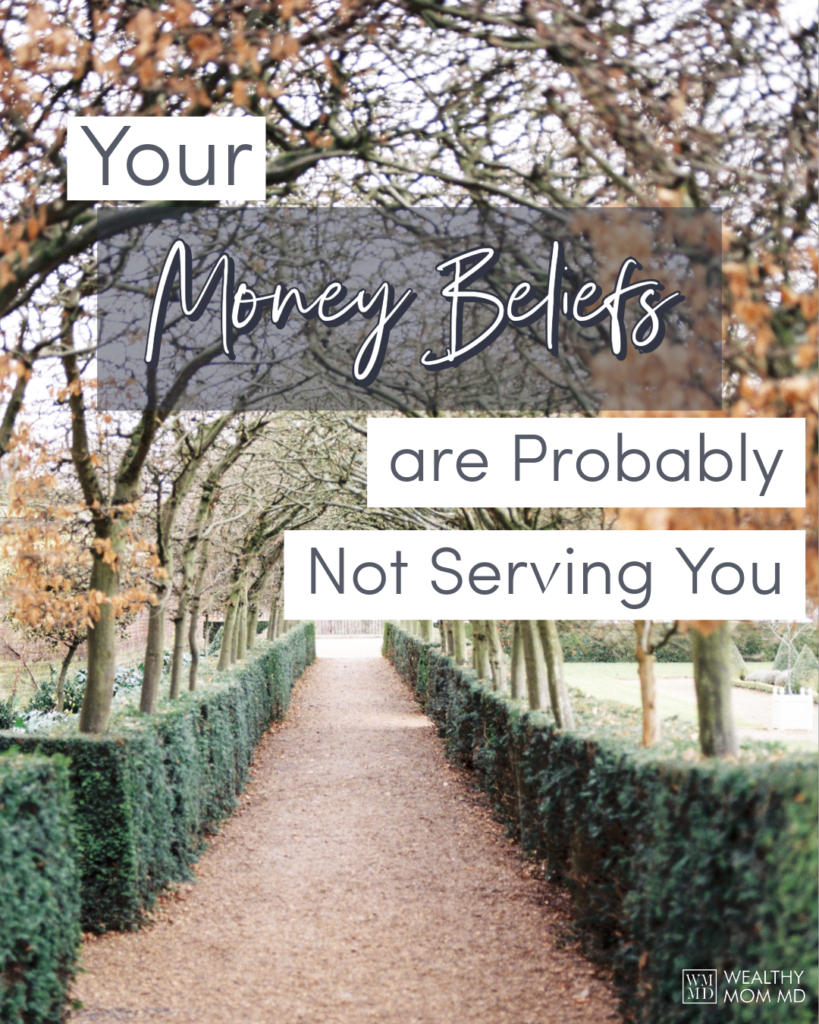
Fast forward – I’m in middle school and I’ve started making some money with a babysitting job. At that time, the fancy people had these black suede shoes by Bass — and I’ve finally saved up enough money to buy myself a pair. I’m so proud of myself and thrilled that I can finally have these shoes. So I go to the mall with friends and buy them. But my mom made me return them. She said they were too expensive and it’s not good to want or have nice things. I remember feeling ashamed to want something nice for myself.
It’s bad to want nice things.
What money beliefs did you grow up with?
Your Current Money Beliefs
For the most part, our past informs our present beliefs–perhaps somewhat upgraded:
“I’m a pediatrician so I’ll never be rich”
“It’s too late for me to retire early”
Over a year ago I found myself in a private practice not making what I thought I was going to make. I was angry and blamed my employer for months. My belief at the time was something like this “It’s their fault I’m not making enough money.” And I felt incredibly trapped. It wasn’t until I was able to see that this was a belief and not the truth that I was able to do something about it. As long as I was placing blame on them there was absolutely nothing I could do about it.
Have you ever paused and considered whether these thoughts are actually true or not? For some of us – you’ve believed these thoughts over and over again so many times that they seem like the truth. And other people (your colleagues) agree with you … further validating your beliefs.
What if all of these beliefs are not true? What if I told you that these thoughts are not only NOT true but you have the ability to create new money beliefs?
If you could believe anything about money – what would you believe?
If you could believe anything about money – what would you believe? Click To TweetHow about:
“Money is easy”
“Money is fun”
This may seem like a big stretch for you if you currently believe money is hard. Using bridge thoughts may help such as:
“It’s possible that money isn’t hard”
“I’m open to learning that money can be easy”
What we think and believe is paramount because it affects how we feel which in turn affects our behavior or actions.
What does our behavior and actions over time give us? Our life. Everything we have or don’t have, everything we are now, is because of actions we took over time.
What do you think truly wealthy people think about money? I bet it isn’t “Money is hard to come by.” It’s easy to think they are unique or unicorns instead of considering whether what they are able to do is available to us.
Your new money beliefs should make you feel good! Now identify one action you can take towards creating wealth. Write it down! You do not need to know the whole plan or how-to at this point.
Read More









